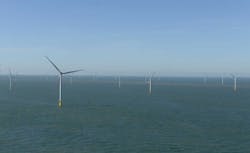UAE’s Masdar invests $13.9B to Buy 49 percent Stake in RWE's 3 GW Offshore Wind
United Arab Emirates (UAE)-based Masdar is investing more than 11 billion Euros (US$13.9 billion) into the UK's renewable energy sector and purchasing a 49 percent stake in RWE's 3 GW Dogger Bank South (DBS) offshore wind project.
This deal is part of the UAE-UK Sovereign Investment Partnership (UK-UAE SIP) to invest in technology, infrastructure and the energy transition. The deal is expected to be completed in the first quarter of 2024 depending on customary approvals.
The project will not only create 2,000 jobs during construction and more than 1,000 direct and indirect jobs during their operational phase but also reduce emissions while powering 3 million British homes.
The DBS offshore wind farms, located over 100 km off the northeastern coast of England, will be divided into two sites, the DBS East Array and the DBS West Array each with a 1.5 GW capacity and covering over 500 sq km.
RWE will have a 51 percent share in the project to remain in charge of development, construction and operation throughout the life cycle of the projects.
While the construction phase is expected to begin by end of 2025, the project will be fully commissioned by end of 2031. 800 MW of electricity is planned to be introduced in 2029.
“As global leaders strive to form a unified and urgent plan to tackle the climate crisis at COP28, Masdar will continue to expand its wind energy portfolio as we target a total global capacity of 100GW by 2030 in support of key climate goals,” said Masdar's Chief Executive Officer, Mohamed Jameel Al Ramahi.
According to the International Renewable Energy Agency, offshore wind energy is anticipated to generate 380 GW by 2030 as far as investment is increased and permitting protocols are accelerated.
RWE will invest $59.63 billion worldwide in offshore and onshore wind, solar energy, batteries, flexible generation, and hydrogen projects between 2024 and 2030. The company's green portfolio will increase to more than 65 GW of generation capacity by the end of 2030.
RWE is decarbonizing its business in line with the 1.5-degree reduction pathway and will phase out coal by 2030 to be net zero by 2040. The company also aims to grow its global offshore wind capacity from the current 3.3 GW to 10 GW in 2030.
